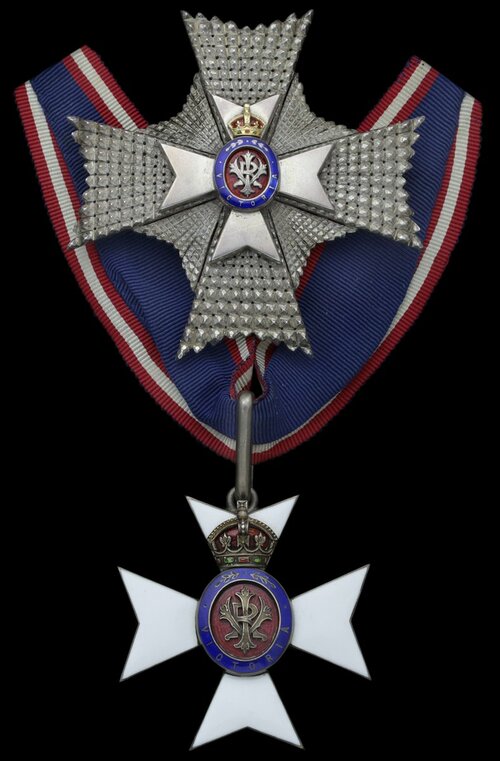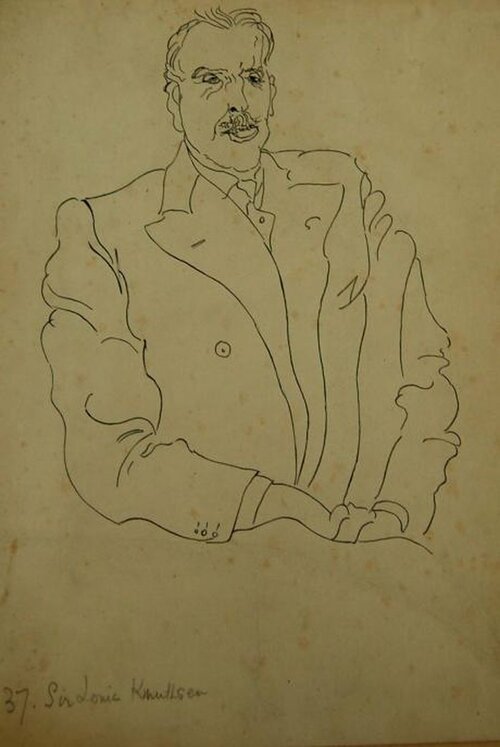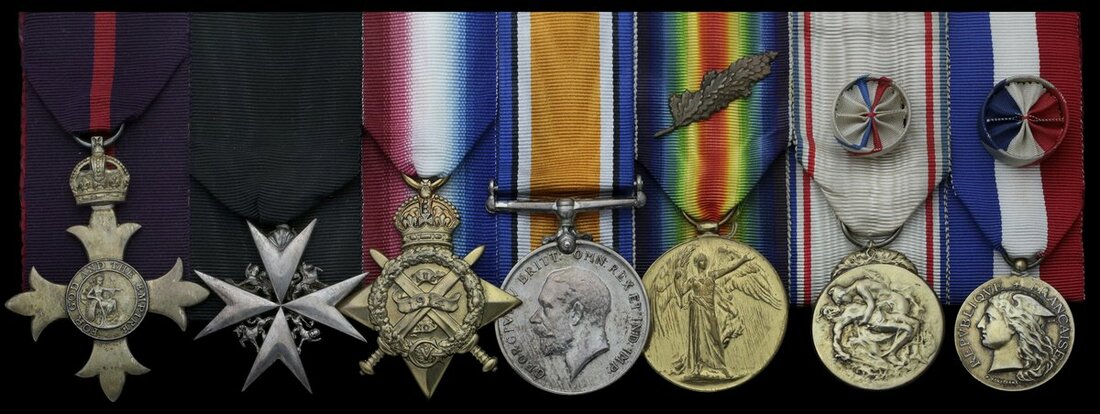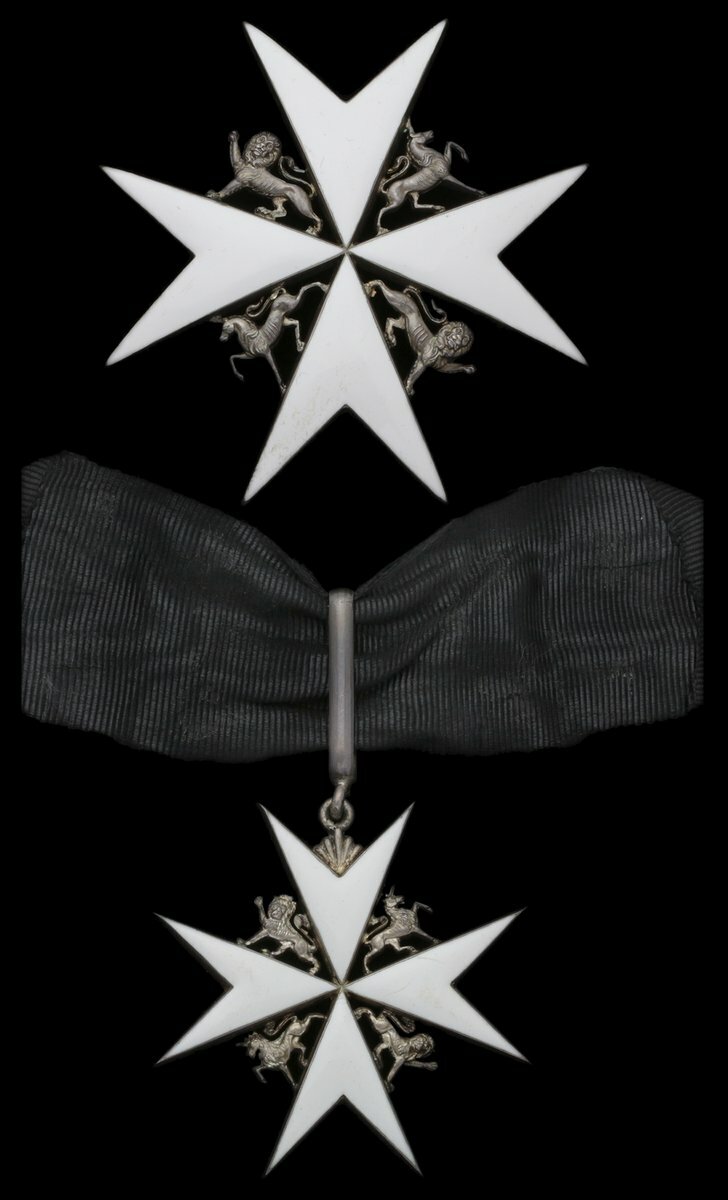Auction: 21003 - Orders, Decorations and Medals
Lot: 480
'Sir Louis Knuthsen, known to all of his friends as "K", was perhaps the best-educated medical man I have known. He had travelled extensively and intelligently in his younger days, and had important friends in every country in Europe. His opinion on almost any subject or event was informed 'from the inside', and was invariably delivered in entertaining fashion. His evident kindness always inspired active affection both in his patients and his friends. As he grew older his ripe wisdom became invariably apparent and was widely valued. After the death of his wife in 1946 he seemed lonely, and his chief pleasure was in the society of his friends, young and old. In summer his tall, handsome figure, dressed in the height of Edwardian fashion, could be seen most afternoons strolling up towards "Lord's."'
His obituary, The Lancet of July 1957, refers
The important K.C.V.O., O.B.E., K. St. J., group of eleven awarded to Major Sir L. F. R. Knuthsen, Royal Army Medical Corps and British Red Cross Society, who commanded No. 5 B.R.C. Hospital at Wimereux during the Great War, affectionately known as 'Lady Hadfield's Hospital', and later became a hugely respected and admired physician to the Princess Royal, with a particular specialism in diseases of the skin
The Royal Victorian Order, K.C.V.O., Knight Commander's set of Insignia, comprising neck Badge, silver-gilt and enamel; breast Star, silver, silver-gilt and enamel, with gold retaining pin, both pieces officially numbered, '506'; The Order of St. John of Jerusalem, Knight of Grace, neck Badge and breast Star, silver-gilt and enamel; The Most Excellent Order of the British Empire, O.B.E. (Military) Officer's 1st type breast badge, silver-gilt; The Order of St. John of Jerusalem, Officer's (Brother's) breast Badge, silver; 1914 Star (L. F. Knuthsen. B.R.C.S. & O.St.J.J.); British War and Victory Medals, M.I.D. oak leaves (Major L. F. Knuthsen.); France, Republic Reconnaissance Medal, silver, unnamed as issued; France, Republic, Medaille d'Epidemies, silver (Major L. Knuthsen 1920), good very fine (11)
K.C.V.O. London Gazette 1 January 1936.
O.B.E. London Gazette 3 June 1919.
K. St. J. London Gazette 17 July 1936.
Louis Francis Roebuck Knuthsen, formally known as Louis Francis Behagen Knuthsen until 1925, was born in 1871 at Santa Cruz, Trinidad & Tobago, the son of Francis Knuthsen and his wife Anne (nee Roebuck). Educated at Edinburgh Academy and at Edinburgh University, he graduated M.B., C.M. in 1893 and proceeded to become a Doctor of Medicine in 1901. After graduation he was in general practice for a short time in Truro, Cornwall, and later at Falmouth, where he became consulting surgeon to the town hospital and a lecturer on ambulance work for Cornwall County Council. He was also local secretary of the British Medical Association in Falmouth before transferring to Shifnal in Shropshire, where he remained until he finally settled in London in 1903. A busy practitioner, these early and relatively rural placements were interspersed with post-graduate study at Paris, Berlin and Vienna Universities.
Whilst in Cornwall - likely dealing with regular injuries associated with the packet ships, fishing and mining industries and agriculture - Knuthsen developed a strong interest in first aid. In London he fostered this passion as a lecturer and examiner for the London County Council, whilst also becoming clinical assistant at the Hospital for Diseases of the Throat at Golden Square, and at the Hospital for Sick Children, Great Ormond Street. In 1904 he determined to specialise in dermatology and was appointed clinical assistant at St. John's Hospital for Diseases of the Skin. He was promoted to casualty medical officer of the hospital, and, in 1908 was appointed assistant physician.
During the Great War, Knuthsen served as one of 236 doctors sent overseas by the Joint War Committee of the British Red Cross, and soon became officer-in-charge of the 100-bed, British Red Cross Hospital at Wimereux in the Pas-de-Calais. Here he served alongside Lady Frances Belt Hadfield, C.B.E., wife of the silicon steel tycoon, Sir Robert Hadfield, who offered significant financial aid for the treatment of wounded and sick servicemen (The Obituary of Lady Hadfield, The Times, refers). Aside from the risk of disease and aerial bombardment, the role was not without risk; several members of a similar unit sent to Serbia in October 1914 were captured by the invading Austro-German army at Vrnjatchka Banja and were held as POW.'s in Belgrade until March 1916.
Appointed Honorary Major in the Royal Army Medical Corps, Knuthsen was twice mentioned (London Gazette 25 May 1918 & 10 July 1919, refer), besides earning an O.B.E. and his French awards. In particular, Knuthsen had developed a reputation for the treatment of skin diseases, likely trench foot, but also diseases associated with lice and the stagnant water which plagued trench warfare, especially during the Third Battle of Ypres. His findings were published in a paper titled The Treatment of Scabies in France - a work of considerable significance given the fact that one study in 1915 found that 95% of soldiers were infested with an average lousiness of 20 lice per man, with 5% having 100-300 lice each (Medical Services: Hygiene of the War, by W.G. Macpherson, refers).
Knuthsen's work complimented that of Alexander Fleming who spent the war studying wound infections in the British Army General Hospital that had taken over Boulogne Casino. Whilst there remained at this time no antibiotics, the work of such dedicated medical practitioners meant that the majority of important pathogens had been discovered and were now amenable to laboratory investigation. Not ignoring the huge impact that the provision of clean drinking water had on soldiers in the trenches, it is perhaps remarkable that only 260 British soldiers died during the entirety of the Great War from typhoid and paratyphoid. On the other hand, trench fever still caused a fifth of admissions to casualty clearing stations, its most famous casualty being A. A. Milne, author of Winnie-the-Pooh.
As the conditions of the unwounded living in the trenches became an enormous military problem, so the ability to study the contamination by scratching of louse faeces into a man's skin offered an opportunity to tackle a problem which had haunted the poorest in civilian society for hundreds of years, most famously in the overcrowded Victorian slums of London. In The First World War, historian Hugh Strachan wrote positively about the trenches:
'Trenches saved lives. To speak of the horror of the trenches is to substitute hyperbole for common sense: the war would have been far more horrific if there had been no trenches. They protected flesh and blood from the worst effects of the firepower revolution of the late 19th century.'
What Strachan had failed to say was that the sheer misery associated with diseases and parasites in the trenches also had a positive impact upon the lives of future generations through accelerated medical advancement by doctors such as Knuthsen; whilst small outbreaks caused by the sarcoptes scabiei mite still occur today in the British army and civil society, the availability of permethrin cream means that the likelihood of hospitalisation is very unlikely (The British Medical Journal, 'The Scabies Problem on Active Service', refers).
Appointed C.V.O. in 1934, Knuthsen was appointed Physician-in-Ordinary to the Princess Royal the following year and attended her when she had an appendicitis operation at around that time (The Herald Express, 8 July 1957, refers). In 1936 he was made K.C.V.O. and in 1951 he became an Extra Physician to the Princess Royal. He also served as a Knight of Grace of the Venerable Order of St. John of Jerusalem and was one-time Vice President of the British Hospitals Association. Knuthsen was also a warden of the Queen's Chapel of the Savoy, following in the footsteps of Sir William Goschen who had served in the role for 43 years (The Coventry Evening Telegraph, refers).
A keen horse rider and cricket enthusiast, Sir Louis died on 7 July 1957 at home in Chesham Street, Belgrave Square, eleven years after the passing of his wife Mildred. His will left £500 to Edinburgh Academy, requesting that it be used to assist sporting activities; sold with copied British Medical Journal, Who Was Who and The Lancet obituaries besides copied research.
He was sketched by Muriel Swinstead, who latterly married the 8th Earl Poulett.
Subject to 20% VAT on Buyer’s Premium. For more information please view Terms and Conditions for Buyers.
Sold for
£3,000
Starting price
£1600













